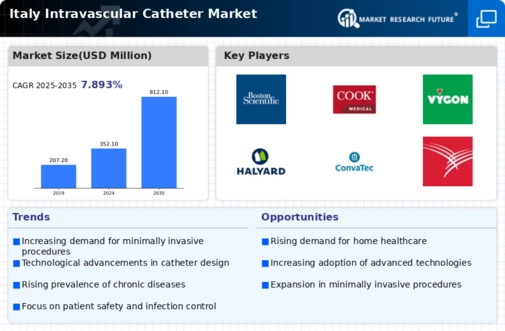Advancements in Medical Technology
Technological innovations play a crucial role in shaping the intravascular catheter market. Recent advancements in materials and design have led to the development of catheters that are safer, more effective, and easier to use. For instance, the introduction of antimicrobial coatings and biocompatible materials has significantly reduced the risk of infections and complications associated with catheter use. In Italy, the market for advanced catheter technologies is projected to grow at a CAGR of 7% through 2030, driven by the demand for improved patient outcomes. Furthermore, the integration of digital technologies, such as smart catheters equipped with sensors, is expected to enhance monitoring capabilities and patient safety. As healthcare providers increasingly adopt these innovations, the intravascular catheter market is likely to experience robust growth, reflecting the ongoing commitment to enhancing medical care.
Rising Prevalence of Chronic Diseases
The increasing incidence of chronic diseases in Italy is a primary driver for the intravascular catheter market. Conditions such as cardiovascular diseases, diabetes, and cancer necessitate frequent medical interventions, leading to a higher demand for intravascular catheters. According to recent health statistics, approximately 30% of the Italian population suffers from at least one chronic condition, which underscores the need for effective treatment options. This trend is likely to propel the market forward, as healthcare providers seek reliable solutions for patient management. The intravascular catheter market is expected to witness substantial growth, with projections indicating a compound annual growth rate (CAGR) of around 6% over the next five years. As healthcare systems adapt to these challenges, the demand for advanced catheter technologies will likely increase, further driving market expansion.
Growing Demand for Home Healthcare Solutions
The trend towards home healthcare solutions is reshaping the intravascular catheter market in Italy. As patients increasingly prefer receiving care in the comfort of their homes, healthcare providers are adapting their services to meet this demand. This shift is particularly relevant for patients requiring long-term intravenous therapy, where intravascular catheters are essential. The home healthcare market in Italy is projected to grow by 10% annually, driven by an aging population and advancements in telemedicine. Consequently, the intravascular catheter market is likely to benefit from this trend, as more patients seek outpatient care options. The convenience and cost-effectiveness of home healthcare solutions are expected to drive the adoption of intravascular catheters, further contributing to market growth in the coming years.
Aging Population and Increased Healthcare Expenditure
Italy's aging population significantly influences the intravascular catheter market. With a median age of over 47 years, the country faces a growing demographic of elderly individuals who often require complex medical procedures. This demographic shift is accompanied by increased healthcare expenditure, as the government allocates more resources to cater to the needs of older patients. In 2025, healthcare spending in Italy is projected to reach approximately €200 billion, reflecting a commitment to improving patient care. The intravascular catheter market stands to benefit from this trend, as healthcare providers invest in advanced medical technologies to enhance treatment outcomes. The rising demand for minimally invasive procedures among the elderly population is likely to further stimulate market growth, as intravascular catheters are essential for various diagnostic and therapeutic applications.
Increased Focus on Patient Safety and Quality of Care
The emphasis on patient safety and quality of care is becoming increasingly prominent in Italy's healthcare landscape. Regulatory bodies and healthcare institutions are prioritizing the implementation of best practices to minimize risks associated with medical procedures. This focus is particularly relevant to the intravascular catheter market, where complications such as infections and thrombosis can have serious consequences. As a result, healthcare providers are investing in high-quality catheters that meet stringent safety standards. The market is expected to grow as hospitals and clinics adopt evidence-based practices to enhance patient safety. In 2025, it is anticipated that the demand for high-quality intravascular catheters will increase by approximately 15%, reflecting the healthcare sector's commitment to improving patient outcomes and reducing adverse events.






















Leave a Comment